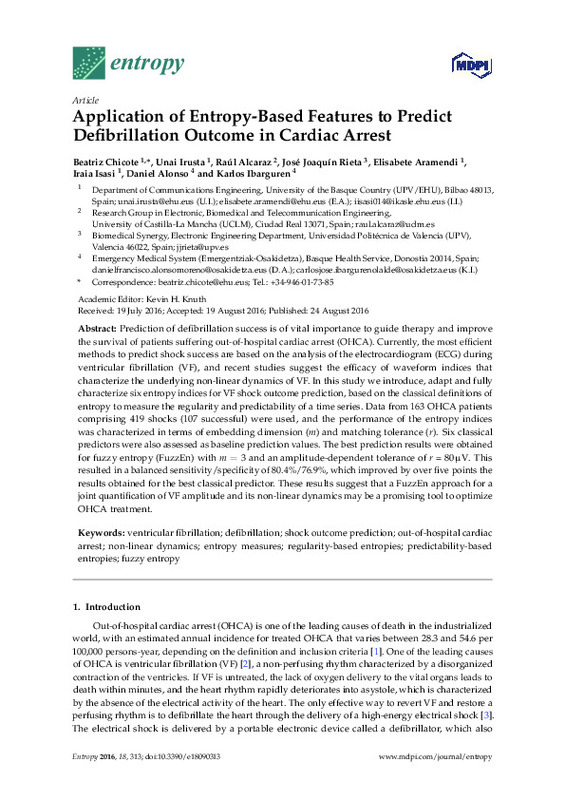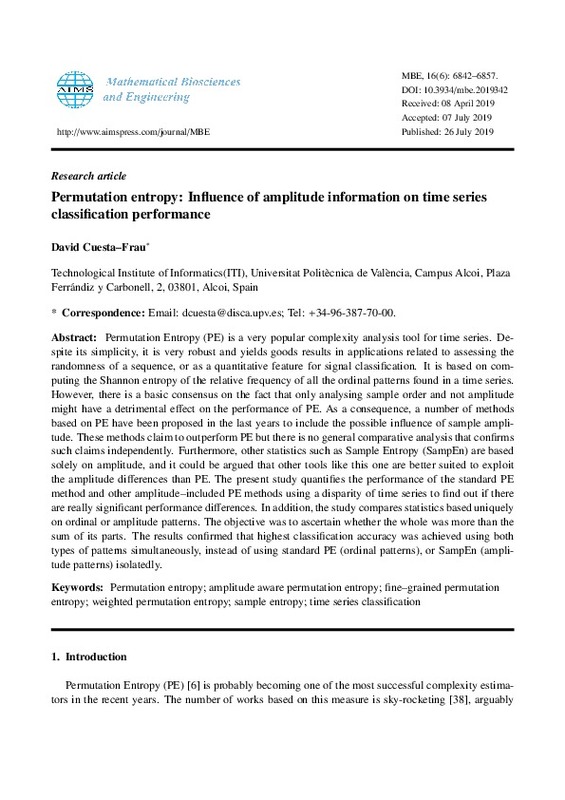JavaScript is disabled for your browser. Some features of this site may not work without it.
Buscar en RiuNet
Listar
Mi cuenta
Estadísticas
Ayuda RiuNet
Admin. UPV
Application of Entropy-Based Features to Predict Defibrillation Outcome in Cardiac Arrest
Mostrar el registro sencillo del ítem
Ficheros en el ítem
| dc.contributor.author | Chicote, Beatriz
|
es_ES |
| dc.contributor.author | Irusta, Unai
|
es_ES |
| dc.contributor.author | Alcaraz, Raul
|
es_ES |
| dc.contributor.author | Rieta, J J
|
es_ES |
| dc.contributor.author | Aramendi, Elisabete
|
es_ES |
| dc.contributor.author | Isasi, Iraia
|
es_ES |
| dc.contributor.author | Alonso, Daniel
|
es_ES |
| dc.contributor.author | Ibarguren, Karlos
|
es_ES |
| dc.date.accessioned | 2017-03-16T15:01:18Z | |
| dc.date.available | 2017-03-16T15:01:18Z | |
| dc.date.issued | 2016-09 | |
| dc.identifier.issn | 1099-4300 | |
| dc.identifier.uri | http://hdl.handle.net/10251/78821 | |
| dc.description.abstract | Prediction of defibrillation success is of vital importance to guide therapy and improve the survival of patients suffering out-of-hospital cardiac arrest (OHCA). Currently, the most efficient methods to predict shock success are based on the analysis of the electrocardiogram (ECG) during ventricular fibrillation (VF), and recent studies suggest the efficacy of waveform indices that characterize the underlying non-linear dynamics of VF. In this study we introduce, adapt and fully characterize six entropy indices for VF shock outcome prediction, based on the classical definitions of entropy to measure the regularity and predictability of a time series. Data from 163 OHCA patients comprising 419 shocks (107 successful) were used, and the performance of the entropy indices was characterized in terms of embedding dimension (m) and matching tolerance (r). Six classical predictors were also assessed as baseline prediction values. The best prediction results were obtained for fuzzy entropy (FuzzEn) with m = 3 and an amplitude-dependent tolerance of r = 80 μV. This resulted in a balanced sensitivity/specificity of 80.4%/76.9%, which improved by over five points the results obtained for the best classical predictor. These results suggest that a FuzzEn approach for a joint quantification of VF amplitude and its non-linear dynamics may be a promising tool to optimize OHCA treatment. | es_ES |
| dc.description.sponsorship | This work received financial support from Spanish Ministerio de Economia y Competitividad, projects TEC2013-31928 and TEC2014-52250-R, and jointly with the Fondo Europeo de Desarrollo Regional (FEDER), project TEC2015-64678-R; from Junta de Comunidades de Castilla La Mancha, project PPII-2014-026-P; and from UPV/EHU through the grant PIF15/190 and through its research unit UFI11/16. | en_EN |
| dc.language | Inglés | es_ES |
| dc.publisher | MDPI | es_ES |
| dc.relation.ispartof | Entropy | es_ES |
| dc.rights | Reconocimiento (by) | es_ES |
| dc.subject | Ventricular fibrillation | es_ES |
| dc.subject | Defibrillation | es_ES |
| dc.subject | Shock outcome prediction | es_ES |
| dc.subject | Out-of-hospital cardiac arrest | es_ES |
| dc.subject | Non-linear dynamics | es_ES |
| dc.subject | Entropy measures | es_ES |
| dc.subject | Regularity-based entropies | es_ES |
| dc.subject | Predictability-based entropies | es_ES |
| dc.subject | Fuzzy entropy | es_ES |
| dc.subject.classification | TECNOLOGIA ELECTRONICA | es_ES |
| dc.title | Application of Entropy-Based Features to Predict Defibrillation Outcome in Cardiac Arrest | es_ES |
| dc.type | Artículo | es_ES |
| dc.identifier.doi | 10.3390/e18090313 | |
| dc.relation.projectID | info:eu-repo/grantAgreement/MINECO//TEC2014-52250-R/ES/CUANTIFICACION DEL REMODELADO ELECTROANATOMICO EN ARRITMIAS CARDIACAS. DE LA INVESTIGACION A LA TERAPIA PERSONALIZADA./ | es_ES |
| dc.relation.projectID | info:eu-repo/grantAgreement/UPV%2FEHU//PIF15%2F190/ | es_ES |
| dc.relation.projectID | info:eu-repo/grantAgreement/MINECO//TEC2015-64678-R/ES/HACIA LA MONITORIZACION INTELIGENTE EN EL ENTORNO DE LA RESUCITACION CARDIOPULMONAR/ | es_ES |
| dc.relation.projectID | info:eu-repo/grantAgreement/JCCM//PPII-2014-026-P/ | es_ES |
| dc.relation.projectID | info:eu-repo/grantAgreement/UPV%2FEHU//UFI11%2F16/ | es_ES |
| dc.relation.projectID | info:eu-repo/grantAgreement/MINECO//TEC2013-31928/ES/TEC2013-31928/ | es_ES |
| dc.rights.accessRights | Abierto | es_ES |
| dc.contributor.affiliation | Universitat Politècnica de València. Escuela Politécnica Superior de Gandia - Escola Politècnica Superior de Gandia | es_ES |
| dc.contributor.affiliation | Universitat Politècnica de València. Departamento de Ingeniería Electrónica - Departament d'Enginyeria Electrònica | |
| dc.contributor.affiliation | Universitat Politècnica de València. Grupo de ingeniería en bioseñales e imagen radiológica | |
| dc.description.bibliographicCitation | Chicote, B.; Irusta, U.; Alcaraz, R.; Rieta, JJ.; Aramendi, E.; Isasi, I.; Alonso, D.... (2016). Application of Entropy-Based Features to Predict Defibrillation Outcome in Cardiac Arrest. Entropy. 18(9):1-17. https://doi.org/10.3390/e18090313 | es_ES |
| dc.description.accrualMethod | S | es_ES |
| dc.relation.publisherversion | http://dx.doi.org/10.3390/e18090313 | es_ES |
| dc.description.upvformatpinicio | 1 | es_ES |
| dc.description.upvformatpfin | 17 | es_ES |
| dc.type.version | info:eu-repo/semantics/publishedVersion | es_ES |
| dc.description.volume | 18 | es_ES |
| dc.description.issue | 9 | es_ES |
| dc.relation.senia | 321391 | es_ES |
| dc.contributor.funder | Ministerio de Economía y Competitividad | es_ES |
| dc.contributor.funder | Junta de Comunidades de Castilla-La Mancha | es_ES |
| dc.contributor.funder | Universidad del País Vasco/Euskal Herriko Unibertsitatea | es_ES |











